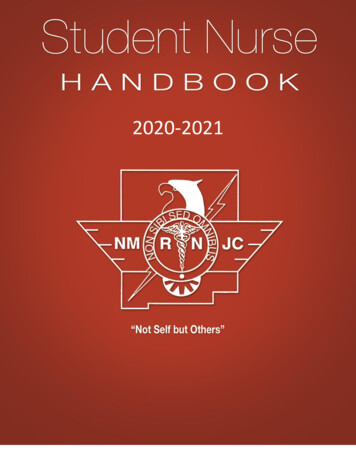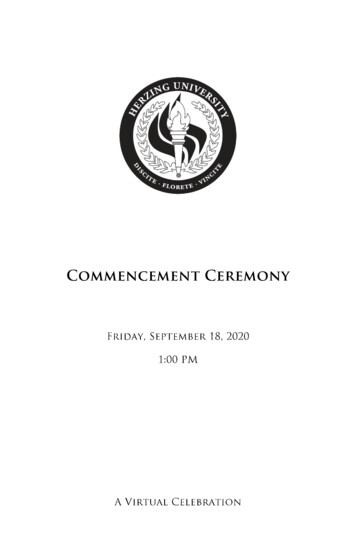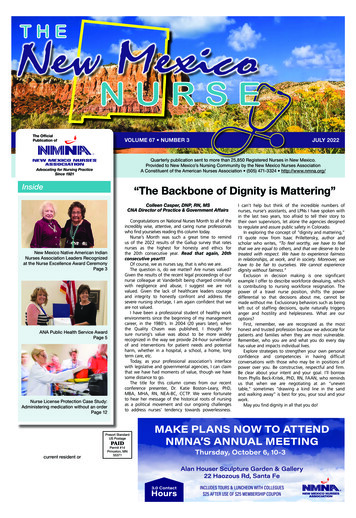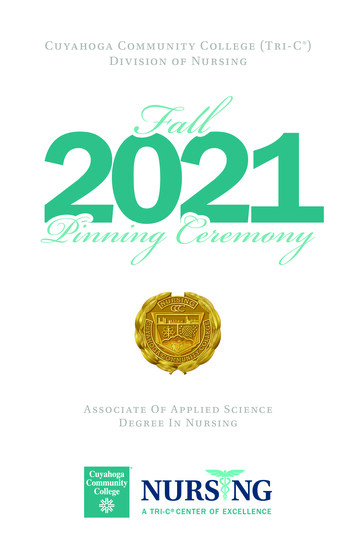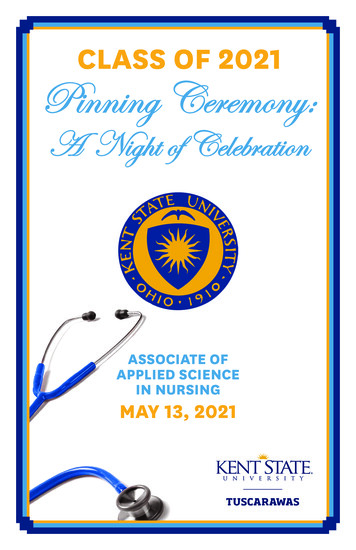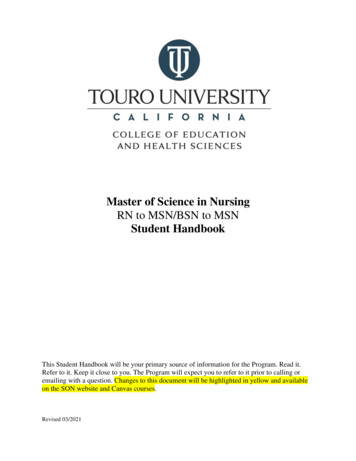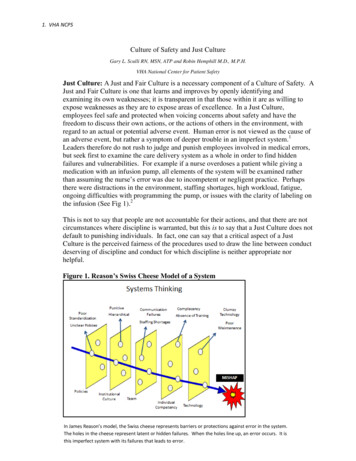
Transcription
1. VHA NCPSCulture of Safety and Just CultureGary L. Sculli RN, MSN, ATP and Robin Hemphill M.D., M.P.H.VHA National Center for Patient SafetyJust Culture: A Just and Fair Culture is a necessary component of a Culture of Safety. AJust and Fair Culture is one that learns and improves by openly identifying andexamining its own weaknesses; it is transparent in that those within it are as willing toexpose weaknesses as they are to expose areas of excellence. In a Just Culture,employees feel safe and protected when voicing concerns about safety and have thefreedom to discuss their own actions, or the actions of others in the environment, withregard to an actual or potential adverse event. Human error is not viewed as the cause ofan adverse event, but rather a symptom of deeper trouble in an imperfect system.1Leaders therefore do not rush to judge and punish employees involved in medical errors,but seek first to examine the care delivery system as a whole in order to find hiddenfailures and vulnerabilities. For example if a nurse overdoses a patient while giving amedication with an infusion pump, all elements of the system will be examined ratherthan assuming the nurse’s error was due to incompetent or negligent practice. Perhapsthere were distractions in the environment, staffing shortages, high workload, fatigue,ongoing difficulties with programming the pump, or issues with the clarity of labeling onthe infusion (See Fig 1).2This is not to say that people are not accountable for their actions, and that there are notcircumstances where discipline is warranted, but this is to say that a Just Culture does notdefault to punishing individuals. In fact, one can say that a critical aspect of a JustCulture is the perceived fairness of the procedures used to draw the line between conductdeserving of discipline and conduct for which discipline is neither appropriate norhelpful.Figure 1. Reason’s Swiss Cheese Model of a SystemIn James Reason’s model, the Swiss cheese represents barriers or protections against error in the system.The holes in the cheese represent latent or hidden failures. When the holes line up, an error occurs. It isthis imperfect system with its failures that leads to error.
2. VHA NCPSDetermining Accountability: One method that facilitates a Just Culture is JamesReason’s Unsafe Acts Algorithm.3 This algorithm can be simplified into the followingfour questions:1. Did the employee intend to cause harm?2. Did the employee come to work under the influence of alcohol or drugs, orequally impaired?3. Did the employee knowingly and unreasonably increase risk?4. Would another similarly trained and skilled employee in the same situation act ina similar manner?If the answer to the first three questions is “no” and the last question “yes”, then theaccountability lies within the system. Even if the questions are not answered exactly thisway, Reason’s algorithm has within it deeper questions that clearly give the benefit of thedoubt to the individual (See Figure 2). The main point to stress here is that a Just Culturehas a specific, fair, and non-arbitrary method of determining system vs. individualaccountability.3,4Improved Reporting: In a Culture of Safety individuals willingly report things that theybelieve to be unsafe. They will swiftly report errors in which they themselves have beeninvolved. This occurs distinctly because they know the organizational culture is fairminded, and leadership will not hold them accountable for failures in the system beyondtheir control. It assumes that they are competent and come to work each day with theintention to do the right thing. In this case people understand that reporting an error orunsafe condition is critical, even if there is no harm; as someone at some point in thefuture may experience the same conditions, and make the same error, which could resultin an unfavorable outcome for a patient. In a Culture of Safety one feels a responsibilityto report on safety issues. Therefore, more reports within a system in one sense can beviewed as a signature of a Safety Culture. It is how those reports are dealt with thatmakes the difference between a culture that seeks to be transparent in finding causationby examining itself as a system, versus one that seeks to quickly assign blame and takepunitive action in the wake of medical error.Figure 2. Reason’s Unsafe Acts Algorithm
3. VHA NCPSHuman Reactions to Failure: An important element in determining causation after anadverse event is to avoid the natural human tendency to react to failure.1 A Culture ofSafety understands these reactions and will consciously make efforts to avoid themduring a focused review of the event. Reactions to failure include:Hindsight Bias – This reaction arises from the ability to look back at an eventwith full knowledge of the outcome. To avoid this, investigators must try toignore this information and understand what those involved in the event at thetime were experiencing, feeling and thinking.Proximal Focus – In this case the focus centers on people who were closest to ordirectly involved in the event; however, many times causation lies far away fromthe time and space where the event occurred.Counterfactuals – This reaction usually begins with “If only”. If only the nursehad not selected the wrong concentration on the pump, the event would not havehappened. This tells us nothing about cause. We need to understand “why” thenurse selected the wrong concentration. Counterfactuals simply lay out for uswhat people did wrong, nothing more.Judgmental – Here snap judgments are made about what people did or shouldhave done; negative words may be used. For example one might say, “Thephysician is inept if he/she missed the patient’s obvious history of bleeding.”This is easy to do and tells us nothing about causation.Human Factors Engineering: As cultures move away from focusing on individuals andmore on systems, they embrace the science of human factors engineering.1 That isattempting to design systems and equipment that fit the manner in which humans work,rather than attempting to force humans to adapt to suboptimal equipment, technology andprocesses.4,5 For example, if hindsight bias is avoided, and we truly embrace anexamination of the patient care system using human factors as a guide, we will often findthat some process, software or hardware created conditions that were ripe for humanerror. In a Culture of Safety, a human factors approach is manifest when examiningadverse events and mishaps.Leaders’ Responsibilities: The job for setting the tone with regard to a Culture of Safetyand a Just Culture rests squarely with top leadership. Leaders must send a message thattalks about safety as a priority and back it up with action.1, 6 They must openly encouragereporting, take the opportunity to reward those that do so, and be sure to providefeedback that steps were taken to change and improve unsafe conditions. Leaders mustchampion the Root Cause Analysis (RCA) process and openly encourage participation ofall disciplines on RCA teams.4 Key in supporting a Culture of Safety is the practice ofleadership walk rounds.3 Here leaders simply walk around the facility and initiateinformal conversations about safety issues or elements that front line staff perceive asbarriers to safe care. Leaders then take this information and share it with departmentheads for discussion. This information can be compared to already existing reportingsystems and RCA data; then clear actions can be taken to resolve the concern. The finalstep in this process is providing feedback to staff that actions were taken to correct theissue; this makes it clear that discussions about safety are not just lip service and garnerstrust, which ultimately affects future reporting efforts.
4. VHA NCPSTeam Training: An additional component in building a Culture of Safety is the initiationand sustainment of a robust team training program that includes the principles ofaviation’s Crew Resource Management (CRM) along with high fidelity clinicalsimulation.5,7 Healthcare is delivered in teams, and the manner in which teamscommunicate is frequently causal in events and mishaps where patients experience deathor major permanent loss of function. Communication failures are one of the top threecauses of Sentinel Events according to the Joint Commission.4,8 Crew ResourceManagement training focuses on team leader behaviors, assertive advocacy tools forsupportive team members, human factors, situational awareness, and clinical decisionmaking; this training is a critical step in reducing hierarchies and providing clinicianswith the skills necessary to communicate effectively in complex, safety sensitiveenvironments.5 Team training programs with didactic and simulation components mustbe perpetual in nature to assure that medical teams have the opportunity to practiceteamwork and communication skills at regular intervals. These skills used in concertwith technical prowess can improve safety and reduce risk in the clinical environment.How to speak up – using the “3Ws” : In a Just Culture the overriding message to staffis that it’s safe to raise concerns about safety. However, “speaking up”, especially in theface of hierarchy or group think may not be easy to do. Therefore, in addition to sayingthat it’s OK to speak up, or “stop the line”, a culture of safety provides guidance on howto do so. Using standardized communication tools is one element of a robust teamtraining program.9 One such tool is called the “3Ws”, which stands for: What I see, WhatI’m concerned about, and What I want.10 Using the “3Ws” is a simple way to stateconcerns and provide feedback that is specific, direct and concise, especially when timeis of the essence. The following case study demonstrates use of the “3Ws”:A nurse is accompanying a resident physician on a medical surgical unit in thehospital. The physician is about to perform a bed side thoracentesis (using aneedle to drain fluid from the lining surrounding the lungs) on a patient who hasbeen having trouble breathing. After obtaining supplies and preparing the patient,the physician picks up a needle and moves toward the patient to start theprocedure. The nurse is concerned that they have not completed a time outchecklist; this is a required step per policy to confirm important elements such asverifying the patient’s identification, verifying the correct side (right or left) onwhich the procedure is to be accomplished, and looking at available radiologicimages. The nurse immediately addresses the physician by simply answering thequestions that comprise the “3Ws”. “I see that we have not completed a time out.”“What I’m concerned about is that we may miss an important step and put thepatient at risk.” What I want us to do is stop and complete a time out beforestarting the procedure”.Notice that the nurse used the words “us” and “we” rather than “you” when addressingthe physician. This is an example of using team oriented language that may lessen thechance team members will feel personally affronted by the statement.
5. VHA NCPSSummary: In summary, leaders must build a Culture of Safety; this includes building aJust Culture. A Just Culture is one where workers feel free to speak up about safetyconcerns and admit errors. In a Just Culture, error is thought to be the result of a humaninterface with an imperfect system that contains hidden failures and vulnerabilities, notthe result of human incompetence or negligence. A Just Culture also has a specific andnon-arbitrary method for determining individual versus system accountability. In aSafety Culture people report concerns and adverse events freely. Focused reviews suchas RCAs are accomplished taking a human factors approach. Leaders will practice walkrounds to garner information about the safety concerns of front-line staff. Leaders takesteps to resolve these issues and communicate actions taken, back to the staff. It is alsoimportant that leaders institute an ongoing team training program so that teams canpractice and master effective communication and decision making skills.
6. VHA NCPSReferences1. Dekker, S., The Field Guide to Human Error Investigations. Published byAshgate Burlington, Vermont. 2002.2. Reason, J., The Human Contribution: Unsafe Acts, Accidents, and HeroicRecoveries. Published by Ashgate Burlington, Vermont. 2008.3. Frankel, A.S., Leonard, M., Denham, C.R., Fair and Just Culture, Team Behaviorand Leadership Engagement: The Tools to Achieve High Reliability. HealthServices Research, 2006; 41: 1690 – 1709.4. The National Center for Patient Safety http://www.patientsafety.gov/5. Kanki, B., Helmreich, R., Anca, J., Crew Resource Management (SecondEdition). Published by Elsevier San Diego, California. 2010.6. Gaba DM. Structural and Organizational Issues in Patient Safety: A Comparisonof Health Care to Other High-Hazard Industries. California Management Review.2001;43:83–102.7. Gaba DM. The Future Vision of Simulation in Health Care. Quality and Safety inHealth Care. 2004;13(suppl 1):i2–10.8. The Joint Commission http://www.jointcommission.org/9. Leonard M, Graham S, Bonacum D. The Human Factor: The Critical Importanceof Effective Teamwork and Communication in Providing Safe Care. Quality andSafety in Health Care. 2004;13(suppl 1):i85–90.10. Sculli GL, Fore AM, Neily J, Mills PD,Sine DM. The case for training VeteransAdministration frontline nurses in crew resource management. J Nurs Adm. 2011;41(12):524-530.
Gary L. Sculli RN, MSN, ATP and Robin Hemphill M.D., M.P.H. VHA National Center for Patient Safety Just Culture: A Just and Fair Culture is a necessary component of a Culture of Safety. A Just and Fair Culture is one that learns and improves by openly identifying and
